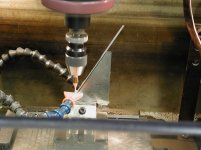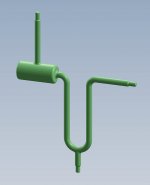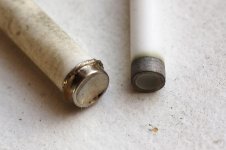Hi hanermo:
Yes the tubes are 316 SS; the coppery appearance is from the light source during photography.
They were assembled by sliding a pin down the coped tube (the short one) and engaging the hole in the long tube.
They were then clamped together with a little jig to hold the short tube at the proper angle.
They were tacked in a couple of spots on each side and the jig removed.
Then they got a root pass at lower power (220V 3.5 milliseconds).
Then they were smoked to reduce the reflectivity and welded with a hot pass of 235 volts and 3.9 milliseconds.
The machine's maximum output is around 60 watts.
You can control the input energy only with voltage, pulse duration, pulse frequency and spot size as Robin Coope mentioned in a previous post, so I have no idea how much power actually went into these welds, but I'd guess a few watts.
All welds are freehand; aligning the joint under the crosshairs and stepping on the trigger pedal to deliver a string of pulses while moving the part under the beam and controlling its position using the crosshair and watching the puddle.
This is not continuous beam welding; the machine makes discrete pulses; and the pulse frequency for welding was 2 hertz (that's about my comfortable limit for freehand welding; when I've got a part mounted on a slide I'll typically double that).
The tubing is 2.5 mm OD and 1.6mm ID.
A freehand weld like this takes about 5 minutes from when I sit down in front of the machine to when I turn it off again.
Maybe a quarter of that time is devoted to aligning the parts and general farting about.
One thing to be aware of with this machine and this style of welding; it is not tightly controlled in any way.
If these ever go to production, the details of the welding process will be completely different even if it's still laser welded.
First, the shielding atmosphere will be properly controlled instead of just an argon pipe dribbling in the vicinity of the weld area.
Second, the welding parameters will be designed properly to achieve the design specs for the weld and experiments will need to be done and the welds tested and etc etc.
Third, there will be proper fixturing and motion control.
Fourth there will be filler metal added.
And etc etc.
So this job will go to a proper laser welding house with modern equipment and process control and with traceability and all that's needed to certify the parts to whatever standard is required.
I'll be long out of the project by then; my job was to knock something together quickly to do concept testing.
The variables you asked about will all be investigated by qualified laser welding engineers, and yes, as you hinted at, they are all influential so the production welding will likely take seconds, and be extremely consistent with exactly the penetration desired, and the weld chemistry predictable and the physical properties and geometry of the weld predictable too.
Compared to the state of the art, what I've got is pathetically primitive; but it serves me very well so long as I keep all that in mind and don't overpromise the performance of welds done on my machine.
I expect to go through several iterations of the design as we work through all the design issues; typically I'll make a few dozen of various configurations over the next months and then I'll never see it again when it goes to production.
On a completely unrelated note; thank you very much billzweig, for sharing your methods for electroplating tiny parts; I appreciate it very much.
There are so many cool new things to learn...this is SO much more fun than when I was a dentist...sadly not as lucrative though!
Cheers
Marcus
Implant Mechanix • Design & Innovation > HOME
www.vancouverwireedm.com











